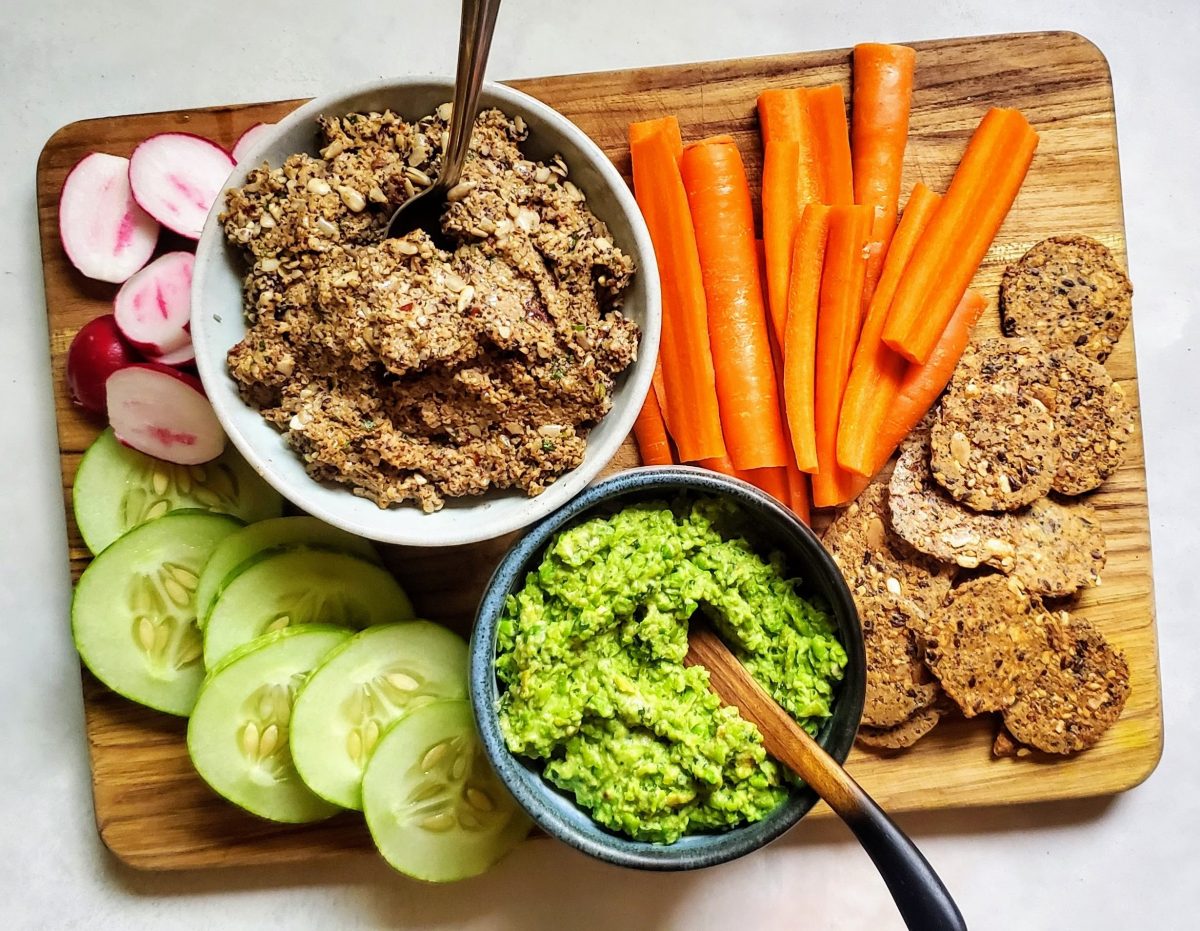
Share this post!
Needing some inspiration for healthy and flavorful dips? If you are looking to serve something other than hummus or guacamole, these two dips may be the perfect options to add to your rotation! This Sunflower Pâté contains soaked sunflower seeds to boost nutrient availability and aid digestion, while the Simple Mint Pea Dip is a wonderful way to use up any excess mint from the garden. Try serving either with cut veggies, flax crackers, on a sandwich, or in a wrap.
Why we love it
Plants contain “anti-nutrients” which inhibit digestion and/or absorption of minerals. All plants have different levels of anti-nutrients, but grains, legumes, nuts and seeds will have the highest amounts. The two main anti-nutrients in nuts and seeds are phytic acid and enzyme inhibitors.
Phytic acid is the storage form of phosphorus in plants. Phytic acid binds with many minerals, especially zinc and iron, preventing mineral absorption. Phytic acid becomes a phytate when it binds to a mineral (these terms are often used interchangeably). Proper preparation can neutralize phytic acid in plants – this can be done by soaking, sprouting and fermenting. Brazil nuts, almonds, hazelnuts and walnuts contain the highest amounts of phytic acid in the plant world (traditionally we have not consumed nuts in quantities that make the phytic acid an issue, but this is an especially important consideration if consuming high amounts of nut flours or butters). Neutralizing phytic acid is particularly important for those who rely on grains, legumes, nuts and seeds for their mineral intake (e.g. vegans and vegetarians). Since minerals cannot be absorbed in sufficient quantities without proper preparation, consuming excessive amounts of phytic acid could lead to mineral deficiencies!
Enzyme inhibitors in raw nuts, seeds, legumes and grains are important to prevent spontaneous sprouting. They block enzyme activity until the plant is ready for germination. However, enzyme inhibitors can also block digestive enzyme activity by making the digestive enzymes ineffective; this reduces our ability to digest the food. This is why for some people, eating large amounts of nuts may cause a sensation of fullness, bloating and other signs of indigestion. Soaking, sprouting and fermenting also neutralizes enzyme inhibitors.
When soaking nuts and seeds, a rule of thumb is to soak 2 cups of nuts/seeds in 4 cups of warm filtered water and 1 tbsp of sea salt. Depending on the nut/seed, soaking time will be 7-24h. If not consuming the nut/seed within a few days, to avoid mold, they can be dehydrated in the oven at a low temperature, or in a dehydrator.
And as for the mint: if you have a garden, your mint may have taken over. This Simple Mint Pea Dip could be the best way to use up any excess of the delicious “weed”! Or, if you don’t have a garden, perhaps a friend has an abundance and is happy to swap in exchange for some delicious dip?
Sunflower Pâté
- 1 cup sunflower seeds soaked overnight (or at least a few hours)
- 1 Tbsp Worcestershire sauce
- 5 sundried tomatoes
- 1/2 garlic clove
- 2 tsp of dulse, finely ground (you can substitute with another salty seaweed)
- 2 Tbsp minced fresh basil
- Salt, to taste
Rinse and drain the soaked sunflower seeds. Simply blend or process all of the above ingredients until a chunky consistency is acquired. This can stay fresh in the fridge for 4-5 days
Recipe adapted from Raw Loulou
Simple Mint Pea Dip
- 3 cups sprouted green peas or frozen peas
- Zest of 1 lemon
- 3 Tbsp lemon juice (approx. 1/2 lemon)
- 1 large clove garlic
- 1/2 cup packed mint leaves
- 2 Tbsp olive oil
- 2 – 4 Tbsp tahini
- ½ Tbsp sea salt
If using frozen peas, leave out to thaw completely.
If using raw peas, blanch the peas (this enhances their sweetness), bring a pot of water to the boil, add peas and cook for 2-3 minutes (no more!). Plunge them into an ice bath or very cold water to halt the cooking process. Set aside.
Add clove of garlic in a food processor and pulse to mince. Add the remaining ingredients and blend on high to puree.
Store in an airtight container for 3-4 days, but try to consume as quickly as possible.
Recipe adapted from My New Roots
More dip recipes to try…
About the Author: Daina Rasutis is a current student of NTI’s Nutrition Therapist Master Program. She plans to use her certification to spark a craving for health through movement, sustainable living and, of course, nourishing food. Follow Daina’s cooking creations and lifestyle tips at www.tabletocrave.com
Image use permission given by Table to Crave
Share this post!


















